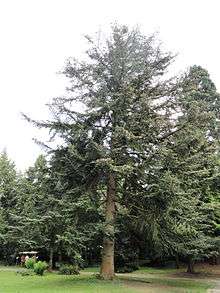Abies chensiensis
Abies chensiensis, the Shensi fir, is a fir native to Gansu, Hubei, Sichuan, Tibet, Yunnan in China and Arunachal Pradesh in India. It was first described by Philippe Édouard Léon Van Tieghem in 1892.[1][2]
| Abies chensiensis | |
|---|---|
 | |
| Scientific classification | |
| Kingdom: | Plantae |
| Clade: | Tracheophytes |
| Division: | Pinophyta |
| Class: | Pinopsida |
| Order: | Pinales |
| Family: | Pinaceae |
| Genus: | Abies |
| Species: | A. chensiensis |
| Binomial name | |
| Abies chensiensis | |
Description
The Shensi fir is a straight-stemmed, evergreen tree, which can reach heights of up to 50m and can have a diameter at breast height of up to 250cm.
Distribution
The natural distribution of the Shensi fir is roughly bounded to the north by the Chinese provinces of Shaanxi and Gansu, and to the south by the Yunnan province. It most commonly grows in heights of 2300 to 3000 metres in regions with an annual precipitation between 1000 and 2000 mm.[3]
Uses
The soft, light timber of the Shensi fir is finely grained, and is predominantly used as a construction material.
References
- Farjon, A.; Li, J.-y.; Li, N.; Li, Y.; Carter, G.; Katsuki, T.; Liao, W.; Luscombe, D; Qin, H.-n.; Rao, L.-b.; Rushforth, K.; Yang, Y.; Yu, S.; Xiang, Q. & Zhang, D. (2011). "Abies chensiensis". IUCN Red List of Threatened Species. 2011: e.T42274A10675568. doi:10.2305/IUCN.UK.2011-2.RLTS.T42274A10675568.en.
- "Abies chensiensis". International Plant Names Index (IPNI). Royal Botanic Gardens, Kew. Retrieved 11 March 2009.
- Christoph J. Earle. "The Gymnosperm Database - Abies chensiensis". conifers.org. Archived from the original on 30 April 2019. Retrieved 25 September 2019.
| Wikimedia Commons has media related to Abies chensiensis. |
